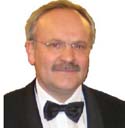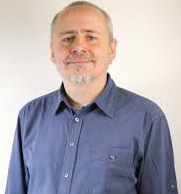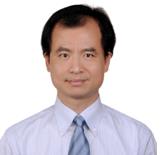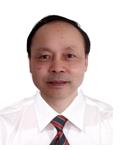
The 5th Global Conference on Materials Science and Engineering
November 8-11, 2016, Tunghai University

 |
Prof. Yesong Gu Department of Chemical and Materials Engineering, Tunghai University Speech Title: Enzymatic Synthesis of Conductive Polymers |
| Abstract: During the past two decades, conductive polymers have been under intensive research and development. Among them, polyaniline (PANI) and poly(3,4-ethylenedioxythiophene) (PEDOT) have received a significant amount of attention because of their lower bandgap energy, remarkable redox-activity, good stability, high conductivity, and pronounced electrochromic properties. Although chemical and electrochemical polymerizations of aniline or EDOT are considered as simple and inexpensive approaches for the synthesis of conductive PANI or PEDOT, they are generally carried out in less environmentally friendly conditions. In particular, the synthesized PANI and PEDOT show the poor solubility in common solvents that is difficulty for further processing. In my laboratory, we have explored the enzymatic polymerization of either PANI or PEDOT, where the polymerization is usually conducted under the mild conditions with a green chemical process. Further modifications and characterizations have demonstrated that the enzymatic synthesized PANI and PEDOT possessed excellent electrochemical properties. | |
 |
Prof. Sigitas Tamulevičius Member of the European Materials Research Society Professor of the Physics Department, Kaunas University of Technology (KTU) Speech Title: Optical properties of noble nanoparticle based structures |
|
Abstract: Nanoparticles of noble metals demonstrate interesting properties of local enhancement of electromagnetic field, catalytic activity and many other unique properties finding multiple applications. Properties of such nanoparticles depend on their size distribution, mutual position and surrounding material. Now days often the goal is to use the nanoparticles as building blocks and assemble them into prescribed and complex structures in order to harvest their unique properties and realize them in novel nanoelectronic, biosensors and photonic devices. In the current research we analyse bottom-up and top-bottom and approaches in the production of diverse nanoparticle based systems.More... | |
 |
Dr. William M. Cox Director and Principal Consultant, Corrosion Management Limited Speech Title: Corrosion Issues in Fossil Fuelled Power Generation Systems – An Update |
|
Abstract:In many respects, the corrosion control concerns in the fossil fuelled power generation industry have remained unchanged over the course of the past thirty or forty years, and still remain so in the large coal-fired units that still provide the majority of base-load capacity. Thus, high temperature corrosion of radiant section membrane walls, superheater and reheater tubes, corrosion of electrostatic precipitator internals, air heater corrosion, and corrosion within both wet and dry FGD systems are still the subject of on-going research. Newer concerns relate to issues such as bromine and iodine addition for mercury control, and the consequent enhancement of air heater corrosion attack, and corrosion in oxy-fuel fired equipment. However, a major shift in the global acceptability of coal-fired power generation has taken place in the USA and is now sweeping across Western Europe which, unless reversed, will result in the extinction of conventional coal-fired boiler plant over the course of the next 10-15 years. However, the unexpected development of supercritical CO2 technology could revolutionise fossil-fuelled electric power generation systems. This presentation will review current thinking and recent advances in corrosion control for conventional fossil-fired combustion systems and also will consider the implications of the emerging power generation technologies. | |
 |
Prof. Willi Pabst Department of Glass and Ceramics, University of Chemistry and Technology, Prague (UCT Prague) Speech Title: Microstructure Characterization of Transparent Ceramics and Ceramic Foams – from Global Microstructural Descriptors to Size Distributions |
| Abstract: Transparent ceramics and ceramic foams are two extreme cases of ceramic materials, the one almost completely dense, the other highly porous. Both are heterogenous materials, i.e. materials with internal boundaries (interfaces). The quantitative description of the microstructure of heterogeneous materials is a basic precondition for applying microstructure-property relations, i.e. predicting effective properties on the basis of microstructural parameters. This contribution gives an overview on stereological methods for the characterization of microstructures, emphasizing curvature-related parameters and correcting some of the misconceptions that frequently occur in the literature. For transparent ceramics (single-phase polycrystalline materials) it is recalled that measures of average grain size can be defined either based on interface density (grain boundary area per unit volume) or mean curvature integral density (or, equivalently, the grain edge length per unit volume). It is shown that these two average grain size measures (mean chord length and Jeffries grain size) are principally independent and uniquely related to two grain size numbers (linear and planar), the difference of which is not adequately taken into account in the corresponding ASTM standard. Further it is shown, that for ceramic foams (highly porous ceramics, a special case of two-phase materials), a generalized Jeffries size can be defined and determined that is also related to the mean curvature integral density. Finally, size distributions of grains and pores are discussed, and pore size distributions obtained from planar sections are compared to results obtained by other methods of microstructural characterization (mercury porosimetry, X-ray computed tomography). The effect of different integral transformations (Saltykov, Cruz-Orive, Woodhead), commonly used to solve the random section problem, is compared, and it is recalled that these transformations have no effect when the object sizes exhibit a Rayleigh distribution. It is shown that, in contrast to common belief, Rayleigh distributions of grain and pore sizes are probably not as rare as commonly assumed. | |
 |
Prof. Chung-Jen Tseng Department of Mechanical Engineering National Central University Speech Title: Pulsed laser deposition of platinum nanoparticles as catalyst for high-performance PEM fuel cell |
| Abstract: In an effort to reduce the cost of the polymer-electrolyte-membrane (PEM) fuel cell, we used pulsed laser deposition (PLD) method to greatly reduce the required Pt amount. The catalyst layers for PEM fuel cell are fabricated by depositing platinum directly onto the gas diffusion layer. This technique reduces the number of steps required to synthesize the catalyst layers and the amount of Pt loading. PEM fuel cells with various Pt loadings for the anode and cathode are investigated. With an anode Pt loading of merely 17ug cm-2 and a cathode Pt loading of 100 ug cm-2, a single cell achieved the same performance as that of a cell using commercial E-Tek Pt/C with much higher Pt loading, 200 ug cm-2 for the anode and 400 ug cm-2 for the cathode. The required Pt amount is reduced to 1/5. Using accelerated degradation test, we also found that the PLD catalysts have better durability as compared to E-Tek Pt/C. | |
 |
Prof. Bin Zhu Faculty of Physics and Electronic Science, Hubei University, China Department of Energy Technology, Royal Institute of Technology Speech Title: From superionic conductor to Solid oxide fuel cell (SOFC): challenges and opportunities |
|
Abstract: The superionic conductors (SC) have characteristics of highly disordered or liquid state of the mobile ions which can fastly transport through network channels, not individual ionic hopping. The SCs are used primarily as the electrolytes in solid oxide fuel cells (SOFCs) and widely for electrochemical devices. In a long history, the SOFC has been dominated by yttrium stabilized zirconia (YSZ) which is based on oxygen vacancy created in the structure and the O2- transport phenomenon relies on the hopping of ions through a fluorite solid structure at high temperature (e.g. 1000oC). The YSZ is in principle not the SC. In order to develop advanced SOFCs for low enough temperatures and technical usefulness, Goodenough proposed the "Oxide-ion conductors by design" (1). However, the proposed structure and doping approach have put strong constraints for SOFC material design and development. Our approach is based on the superionic conduction mechanism on the ionic networking conduction to create the artificial liquid state and superionic channels through interfaces between a rigid solid phase, e.g. oxide-ion ceria structure and a 2nd phase which can be molten or soften at a suitable temperature ≤ 500oC. Typical examples are ceria-carbonate composite materials. These materials have successfully reached 0.1 S/cm at around 300oC (to be comparable to YSZ at 1000oC), resulting in great successes for low temperature SOFCs, e.g. more than 1000 mW/cm2 at ≤ 500oC. Latest developments showed more advanced novel functional semiconductor-ionic materials (SIM) in which the ionic conductivity can be greatly enhanced by strongly correlation between electrons and ions. More interestingly, such SIMs can function for fuel cell anode, electrolyte and cathode, "Three in one" (2), thus creating single-layer electrolyte-free fuel cells (EFFCs) as a revolutionary breakthrough. Therefore, many new opportunities for SOFC R&D have been explored. | |